Airgun Technology (AGT) is a Czech airgun manufacturer with pedigree, boasting rifles such as the Uragan, Vixen and Vulcan in their extensive lineup. There are actually numerous versions of this new Vulcan 3 available, 14 to be precise, but I only have the .22 500 walnut stock version here on test.
The ‘500’ refers to the length of the barrel – 500mm, and there is also a ‘700’ version which has, wait for it, a 700mm-long barrel! The only other main difference between the two models is that the 500 features a 480cc carbon-fibre composite bottle, whilst the 700 has a slightly larger 580cc one.
The 500 is available in .177 and .22 sub-12, plus .25 and .30 FAC versions, wheras the 700 is available all but the .177 calibre.
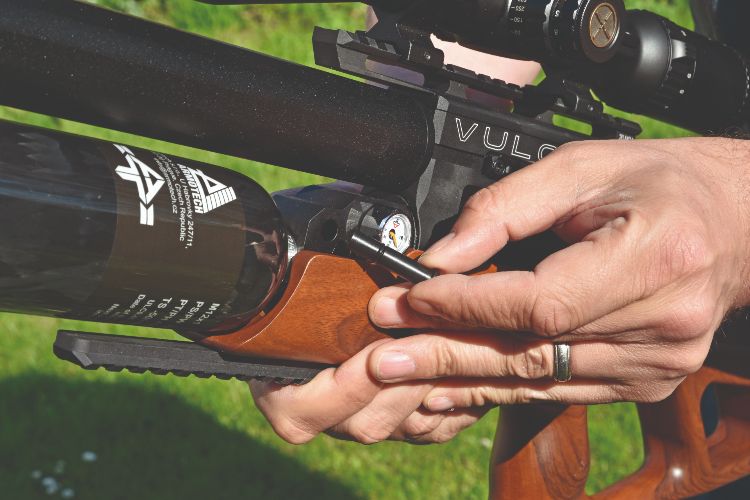 Bullpup design
Bullpup design
From the first glance at the 500 you can tell that it’s one of the many bullpup designs on the market, with the traditional rear-mounted magazine and compact design. There’s so much to talk about with this rifle, and the more I use it the more impressed I am with its overall design and build quality, but then we are talking about a rifle that costs £1,600!
The walnut stock on the rifle I have here is super-smooth and nicely oiled, but there is also a black synthetic stock model available for those who prefer them. The butt pad is adjustable, too.
So how does this Vulcan 3 differ to the Vulcan 2? Well, the folks at AGT have redesigned the monoblock, which is now machined from a single solid piece to improve rigidity and performance. They’ve also redesigned the barrel shroud/moderator, which is now 38mm wide instead of the original 32mm, and I have to say that it is extremely quiet in use. At the end of the shroud you’ll find a screw cap that can be removed to reveal a 1/2in UNF thread so you can add an additional moderator to make it even quieter if you want to. The AGT Moderator costs around £70.
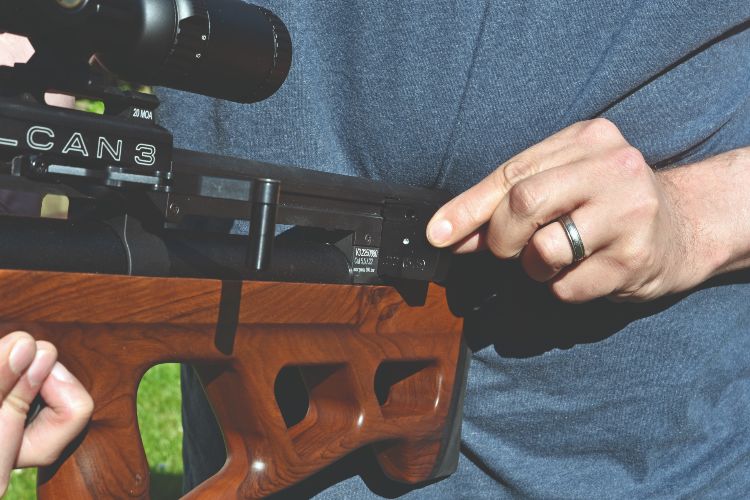 Sidelever action
Sidelever action
The drop-down arm on the lever is cylindrical and relatively short at just 25mm long. It is fixed with no rotation, but polished smooth so it glides between your finger and thumb during cocking.
Speaking of which, this short little lever requires minimal effort to cock the rifle, and we’re talking just a few degrees past 90 before you hear everything engage and the rifle is cocked. Gently pushing the lever forward returns it to the closed position with satisfying muffled ‘click’.
This truly is an ambidextrous rifle. You can move the sidelever from left to right with just a hex key, so there’s no need to take it to a gunsmith.
As far as filling goes, there’s a pull-out plug at the end of the action, just in front of the fill gauge, which reveals the fill port, once removed. This rifle was sent to me with the optional extra Quick Fill Station, which is basically a small pressure release unit that can screw directly into your dive bottle, with a whip and probe attached. Fill your rifle as normal with your dive bottle, then turn the knurled knob on the side of the Quick Fill Station to release the pressure before removing the fill probe and replacing the plug. These units retail for around £110. There’s also a an air discharge port underneath the action, and it is possible to drain air out of the rifle simply by loosening the grub screw if
needs be.
There’s also an internal regulator, which is set at 100 bar for the .177 version and 110 bar for the .22.
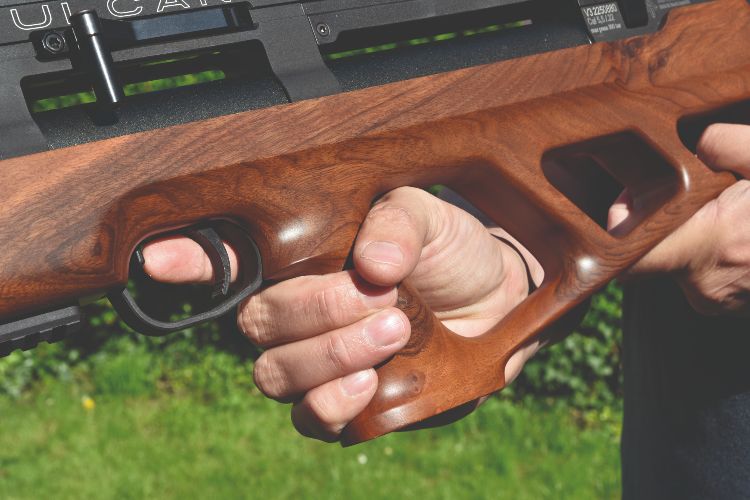 Crisp trigger
Crisp trigger
Straight out of the box, this trigger is set with a short first stage, followed by a crisp release and it’s very easy to gauge when this trigger is going to release, even with it being set at just over 1lb pull weight.
However, if you want to adjust it you’re going to have to remove the stock, which is easily done, but a bit of a pain if you want to make adjustments. I didn’t feel the need for tinkering, and this wide, gently curved trigger blade did everything that I wanted it to.
If I had to find one niggle with this rifle, well actually two, the first is the linkage noise caused when the trigger is pulled. It’s right under your ear as you pull the trigger. Obviously, this doesn’t affect the rifle’s performance, it can just be a little bit annoying sometimes. The second gripe is the trigger blade itself – it’s plastic! On a rifle of this quality I would expect the trigger to be metal. I doubt very much that it will ever break on you, but come on – this is a £1700 rifle!
A small, manual safety lever system sits immediately in front of the trigger blade, easy to operate with the rifle mounted. Pull it back to make the rifle ‘safe’ or push forward to fire. The safety can only be switched on or off when the rifle is cocked.
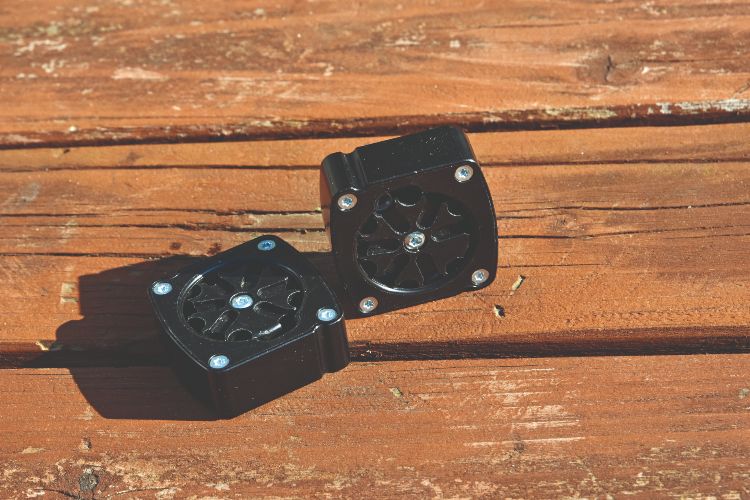 Metal magazines
Metal magazines
I really like the self-indexing mag’s supplied with this rifle, of which there are two supplied. Additional mag’s can be purchased for around £40 each. The outer casing of these mag’s is made from a metal alloy, and they look and feel extremely robust.
Loading the mag’ is easy, simply rotate the hard, synthetic inner core of the mag’ slightly anti-clockwise until you see enough space to drop in a pellet, then continue to rotate the inner core whilst dropping pellets in as you go, until it is full. It’s an easy task and there are plenty of grooves on the inner core to grab hold of with the tip of your finger.
Inserting the mag’ into the rifle is easy, too. It can only go in from left to right due to the piece of material that has been machined out. There’s a small, spring-loaded ball bearing built into the block that slips into the groove at the base of the mag’ once inserted to hold it in place.
I really like how these mag’s sit flush with the action once inserted, it’s a really nice touch, especially seeing as how your cheek is resting on it during shooting.
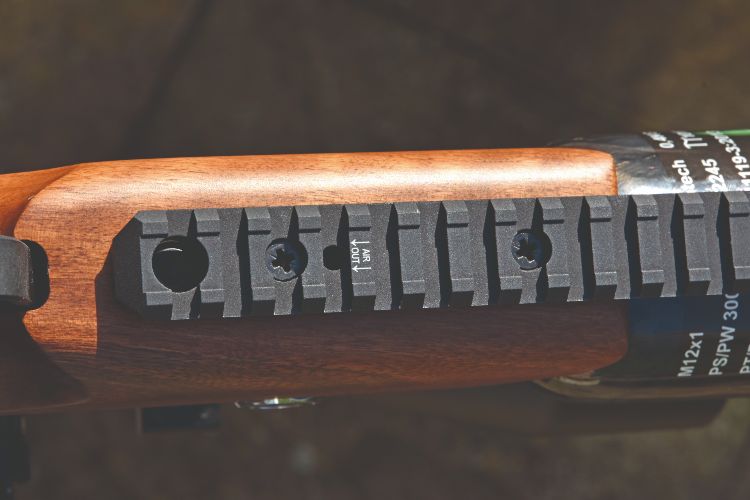 Top and bottom rails
Top and bottom rails
There's a rather nifty 20MOA sloped Weaver rail on top for mounting your scope. I’m guessing that the slope is designed for those who wish to shoot FAC over longer ranges. However, it will also be useful for those shooting sub-12 who want to use some form of digital night-vision or thermal – I’ve had plenty of problems in the past with getting these units zeroed, mainly due to them being designed for shooting at 100+ metres, and quite often I have found the need to shim the rear of the mount, but this sloping rail helps to eliminate all that.
The top rail is a generous one, too, measuring 200mm long, whilst underneath there is a 160mm-long rail for attaching a bipod. I like how it protrudes some 50mm under the air bottle from the end of the stock.
 Conclusion
Conclusion
Yes, it’s got a fairly high price tag, but the Vulcan 3 really does live up to expectations as far as performance goes. It’s extremely well made and an absolute joy to shoot. I was hitting sub-5p groups at 30 metres on the range with ease, and I spent countless hours demolishing targets in my back garden with it, which is in part thanks to the large air capacity allowing me to spend more time shooting without having to stop for refills so often.
Would I buy one? Yes, I would. I think you’ll be pleasantly surprised after shooting one for a few hours. It’s the perfect tool for pest control, and relatively light at 3.5kg unscoped, but it’s equally at home on the range. I’m looking forward to seeing what comes out of the AGT stable next. I think they’ve got a lot of work on their hands if they’re going to better the Vulcan 3!
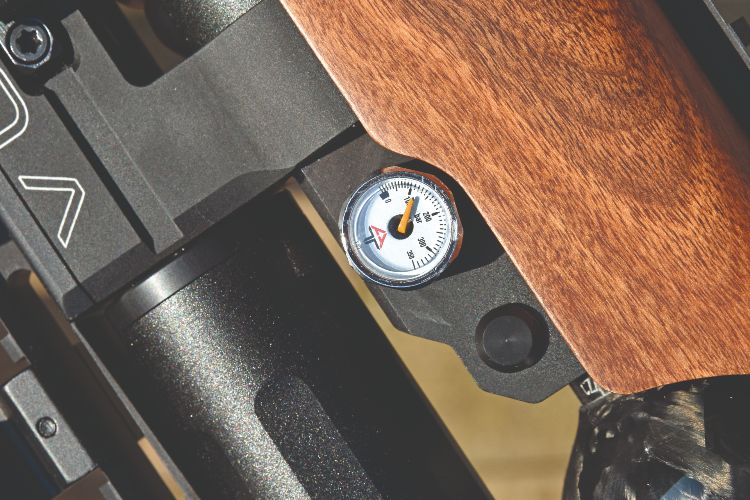 Tech specs
Tech specs
Model: Vulcan 3 500
Manufacturer: AGT (Airgun Technology)
UK Distributor: Edgar Brothers
Type: PCP, multi-shot rotary mag’
Stock: Ambidextrous Walnut or Synthetic
Cocking: Biathlon sidelever (adjustable left or right)
Trigger: Adjustable
Safety: Manual lever
Calibres: .177 (15 shots) and .22 (12 shots)
Overall Length: 797mm (31.3 in)
Barrel Length: 500mm (19.7in)
Weight: 3.5kg (7.7lbs) without scope
Fill Pressure: 300 bar
Shots Per Fill: 440 (.177), 220 (.22)
Energy of Test Rifle: Avg 11.5 ft.lbs. over 20 shots
Variation (20 shots): 7fps
Websites: www.edgarbrothers.com
RRP: £1,700 (£1600 for synthetic stock)